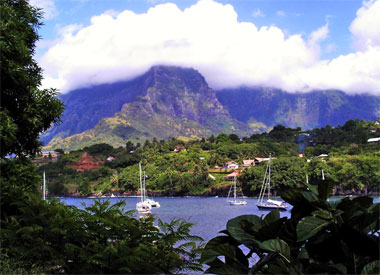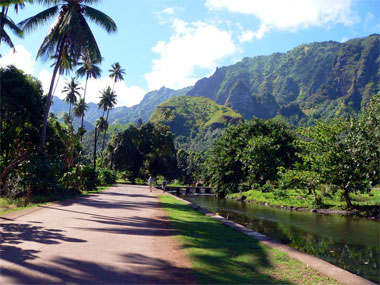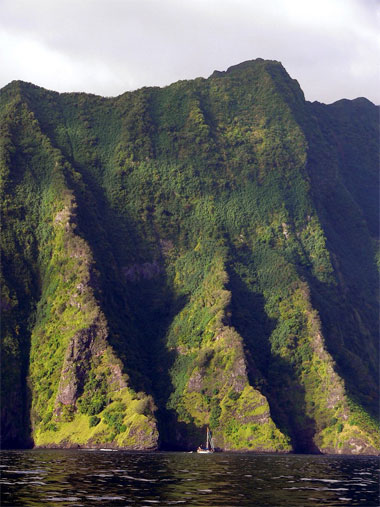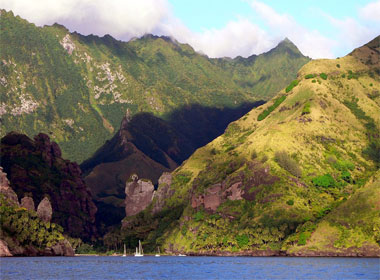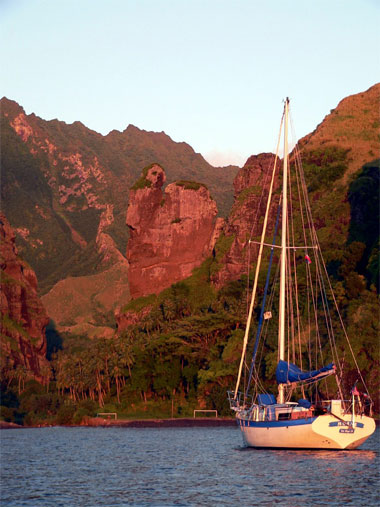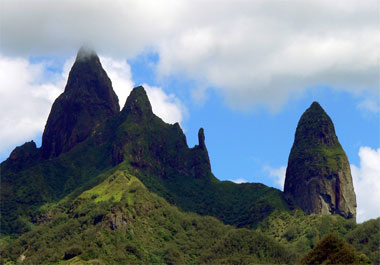The Marquesas Islands
Landfall after 25 days at sea
What follows is an update on the landfall. Sorry about the time to get these e-mails out. We haven’t had access to e-mail for several weeks. Another San Diego boat (thank you Seayanika) was kind enough to allow us to send our updates through their high frequency radio (SSB) e-mail system. Interestingly – these e-mails may be passing through the San Diego Yacht Club’s Winlink system before they reach you.
We're currently on the island of Ua Pou in the Marquesas. We'll be heading to Nuka Hiva in the next few days and will be able to give you an update on the Marquesas. In the mean time here’s what we wrote upon landfall and had hoped to send a couple of weeks ago:
We made it safe and sound. We arrived in Hiva Oa, Marquesas Islands yesterday afternoon. It took Moana 25 ½ days to travel the 2,700 miles from Zihuatanejo, Mexico to the Marquesas Islands. Actually we traveled a little over 3,000 miles. The extra miles were for weather reasons. If we would have went a straight route we would have had a longer passage and rougher weather.
We missed arrival the day before by three or four hours. We realized we weren’t going to make landfall before dark so at sunset we heaved to (parked the boat) ten miles offshore and waited for morning. It ended up being an uncomfortable night as the swells increased and a frontal system came through. When I (Sam) took the four AM watch I could see a squall coming down on us. We rolled up the jib and left the double reefed main out. The squall hit with a lot of wind and rain. It ended up being the longest rain and second highest wind speed we saw the whole trip. Because we had resumed sailing towards Hiva Oa we were in between three islands at the time the squall hit. We were running (sailing term to say we have the wind directly behind the boat) at seven knots directly out the other side of the channel with islands on three sides. Even though all three islands were within 10 miles of us we couldn't see them until the rain stopped two hours later. We then had to backtrack to windward to make landfall at Hiva Oa. Sally had no problem with sea sickness for the entire trip. Ironically that last night was the only night she felt queasy.
When the rain stopped just before sunrise, we could see all three of the islands looming around us. They were an awesome sight. As we got closer to Hiva Oa we began to see just how beautiful the Marquesas Islands are. The smell was heavenly. It is hard to describe: a fresh, sweet, lush, green smell with a fruity tint. Hiva Oa is unbelievably green. There are several peaks over 3000 feet high. The mountains have steep, almost vertical sides to them. We both agree that it is the most beautiful island we've ever seen. We're excited because we've heard some of the other Marquesas Islands are even more amazing. Basically we been told “you ain’t seen nothing yet”. We both agreed that the trip was worth it just to see this one island.
When we arrived to the anchorage we already knew three of the seven boats anchored here. Two we knew from Zihuatanejo and the other we met at Catalina Island last October. After setting the hook we both slept for four hours as we were exhausted. Upon getting up we realized that the town, Atuona, was shut down for the day. We were invited to our friend’s boat for snacks and trading stories about the crossing. As we write this we haven’t been ashore yet. We've been doing chores and straightening up the boat all morning. Sally was busy sewing together Moana’s French courtesy flag .
In reading about the Marquesas Islands before arrival we realized how isolated these islands are. Hiva Oa is the biggest island in the group with a “thriving” population of 1,500. The entire Marquesas Islands has a population of 4,500. The closest “big” city is Papeete, Tahiti and that is 1000 miles away.
We will be heading to Fatu Hiva in a couple of days. We will have very limited access to e-mail for much of the time until we arrive in the Society Islands (in a couple of months), but we will e-mail whenever we can.
We've appreciated everyone’s thoughts and prayer throughout the journey. We spent much time on our trip talking about family and friends.
More to come soon!
Sincerely,
Sam & Sally
s/v Moana
written in Hiva Oa
April 12th, 2005
Bonus Update - A Dark and Stormy Night
Sally and I talked a few days ago about how we are on call 24/7 to take care of the boat. Most of the time things are calm, but the conditions and the weather can change rapidly. Well, our pager went off one night while anchored in Daniel’ Bay on Nuku Hiva. About the time we fell asleep that night it started to rain. We did the quick drill of closing all open hatches and went back to bed.
We were almost asleep again when the wind gusts started to come. We could hear the anchor chain sliding across the rocks 40 feet below. I got up to take a look around and assess the situation. Daniel’s bay is a well protected bay with steep mountains all the way around. Since there was a new moon and no lights ashore, nothing could be seen outside except the lights from two other sailboats anchored nearby.
One of a sailor’s greatest fears is an anchor dragging and the vessel ending up ashore. When conditions are marginal or bad an “anchor watch” must be done to ensure the vessel stays put. One of the traditional ways to determine if your vessel is moving is to take a compass bearing on an object to your side. If the compass bearing has changed on any subsequent bearings, either your vessel or the object your using has moved. Since we could not see a thing besides two other boats behind and in front of us, a bearing wasn't possible.
Now comes the joy of modern electronics. A GPS can be used to ensure that a vessel isn’t moving. I marked our position on the GPS and set it to tell me how far we were from that point. From the warmth of inside Moana I could keep a watch to ensure we were staying put. The GPS even has an anchor zone alarm that can be user set to go off if we move 100ft, 250ft or 500ft. Unfortunately the alarm is quiet and virtually unusable (it would be impossible to be expected to wake up to the alarm when the sound of the wind and rain were at least three times as loud). Nonetheless, I was VERY thankful to have the GPS to aid me in my watch.
The rain continued to come down very heavy. The winds were not great except that they would build up on the other side of the mountain and fall over the peaks in substantial gusts. After I was sure that Moana’s decks had been washed well, I ventured outside to open the fill holes for the water tanks and plug the side deck drains. We were going to fill our tanks with fresh rainwater. I went back inside to survey Moana for leaks. Almost every boat has them. We had only one visible leak which was in the window over the galley. Ironically, I had spent a couple of hours that afternoon fixing a leak caused by inadequate caulking on one of our dinghy tie-down eyes not knowing that it was going to rain cats and dogs that very night.
Meanwhile, we were hunkered down below. Sleep wasn't much of an option. Even if we didn't need an anchor watch, the conditions were too boisterous to get much sleep. I started a book on the voyages of Captain Cook in the South Pacific to pass the time and ease the mind.
About halfway through the night an awesome electrical storm began to come over us. The lightning would light up the sky following by a thunder that would echo and reverberate through the mountains for as much as five seconds. It was a humbling show. Lightning is not always the friend of one who lives in a home with a aluminum stick pointing 50 feet into the sky. Although it is somewhat uncommon for a sailboat to get struck by lightning, it can and will take out every piece of electronics on board. We put our spare GPS, shortwave radio and the laptop computer into the only adequately electronically isolated place on our boat – the gimbaled oven. Many bolts came within a few miles our Daniel’s bay, but we remained safe.
About an hour into the electrical side of the storm the wind shifted to come from the opposite side. Moana quickly swung around to face the opposite shore. I nervously watched our position on the GPS change and prayed that we would remain still when the anchor chain come up taught. It did. The lightning continued for another half hour. The conditions remained unsettled for the rest of the night.
I was relived to see light peaking over the mountains about a half hour before dawn. I could finally see the shore and that we were still as far away as we were the previous night at sunset. I looked out at the peaks and saw many waterfalls where there were none the day before. To my amazement I saw them forming their path halfway down the mountain. I could literally see the moving down only to be blown by the wind back up into a mist. It was an amazing sight.
The rain went to a drizzle shortly after dawn. The wind settled down with it. I was finally able to go to bed with a peace of mind that Sally, Moana and I were safe. My pager remained silent while I slept for the next six hours.
Update #14 - Life in the Marquesas
We are on the eve of our next crossing. It's hard to believe we've already been in the Marquesas for just shy of one month! We absolutely love it here! At the same time we're eager to see the Tuamotus. We are currently visiting our last Marquesan Island, Nuku Hiva, and will be heading out for the Tuamotus Island group on Monday or Tuesday. It should take us four or five days to get there.
Today we will head around the corner to Daniel’s Bay. Daniel is a 72-year-old Marquesan who has lived on this island his entire life and has always been very friendly to cruisers. He has kept a log of cruisers visiting the bay for over 20 years and we're eager to check back on the log from the early 80’s to see if Moana stopped by there on her way to Bora Bora. Some of you will find interesting that Daniel’s Bay was also the location for the filming of Survivor Marquesas. Bless his heart, when offered money for tearing down his house and constructing a new one on the other side of the bay he said he didn't want any money, just a house. He now has his house on the other side of the bay as well as a house in town. We're hoping that we find the island to be untainted from Western influence but we shall see.
We have visited five islands while in the Marquesas: Hiva Oa (pronounced hee-vah-oh-ah), Tahuata (ta-who-ah-tah), Fatu Hiva (fah-too hee-vah), Oa Pou (wah-poo), and Nuku Hiva (noo-koo-hee-vah). We have loved all the islands for different reasons but must say our favorite overall anchorage is in Fatu Hiva.
Fatu Hiva is absolutely magical! There are steep cliffs surrounding the island. Everything is lush and green because of the vast rainfall there. There are palm trees lining different areas of the mountains and flowers everywhere. We enjoyed an hour hike to a 200 foot waterfall where we could swim in the shockingly chilly yet very refreshing fresh water. We were even visited by a three foot fresh water eel! Good thing he was a bit shy!!! We did the hike with our new English friend, Alan, who has been cruising for the past four years by himself. He is quite the character! While up at the waterfall together our new Danish friends arrived. They were a bit shy when they saw the eel and only two of the four of them got in the water.
Along with meeting cruisers from all over the world we have really enjoyed meeting the locals. As we first landed our dinghy on shore at Fatu Hiva a local by the name Felix greeted us and helped us tie up. As we walked in the village Sam noticed Felix carrying a heavy load and offered to help. We went up to his grandmother’s home to deliver the items. Felix told us to wait, came out with a machete, led us down the street, climbed a tree, and cut down six very large pamplemousse for us. These are grapefruits only much sweeter and from what I'm told, a lot better. I've never cared for grapefruit but these are excellent! They are wonderful for breakfast or even for drinking their juice. We were touched by his generosity.
Wood carving and tapa are done by the locals in Fatu Hiva. We were taken by one of Felix’s friends to see wood carvings done by David and his wife. They actually have a table they carved sitting in a museum in France. Their work was by far the best we saw on the island and he and his wife actually worked on the two items we purchased while we were there. We bought a sting ray and a group of dolphins. They were so thrilled we bought a couple items that his wife picked 40 limes from her tree for us and also gave me a hand carved pic for my hair.
We visited a couple different houses to see tapa. Tapa cloth (produced from the inner bark of trees) is an art that only continues on the island of Fatu Hiva. This is very time-consuming and is done by some of the women. The source of the bark determines the color of the tapa cloth; off-white bark comes from the mulberry tree, medium brown is from the breadfruit tree and dark brown comes from the banyan tree. Once the cloth is finished intricate Marquesan drawings in black ink are applied to the cloth. While at another anchorage on Fatu Hiva we were able to watch a woman making tapa.
We have enjoyed snorkeling, hiking, scuba diving and visiting archeological sites! We have learned a few Marquesan words such as Ca-ow-oh-hah (hello), Nah-nah (good-bye) and coh-tau-noo-ee (thank you very much).
Another secret about Moana was discovered while visiting Fatu Hiva. While walking in the village we saw house patio where one of its boards had writing on it. It said “Teverino Moana Fatu Hiva”. That got us thinking. When we arrived at the boat we pulled out our Lonely Planet Phrase Book and thumbed through the Tahitian words. We discovered that Moana is the Tahitian word for “Ocean”. We already knew that it was the Maori (New Zealand native) word for “Blue Sea”. It's fascinating that the different languages in the South Pacific had the same word for ocean.
The Tuamotus are very remote. We may or may not be able to e-mail from there. We will update you whenever we can.
Sincerely,
Sam & Sally
s/v Moana
currently at Nuku Hiva, Marquesas Islands
